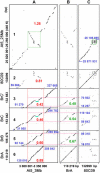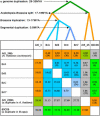Sequence-level analysis of the diploidization process in the triplicated FLOWERING LOCUS C region of Brassica rapa
- PMID: 16632644
- PMCID: PMC1475497
- DOI: 10.1105/tpc.105.040535
Sequence-level analysis of the diploidization process in the triplicated FLOWERING LOCUS C region of Brassica rapa
Abstract
Strong evidence exists for polyploidy having occurred during the evolution of the tribe Brassiceae. We show evidence for the dynamic and ongoing diploidization process by comparative analysis of the sequences of four paralogous Brassica rapa BAC clones and the homologous 124-kb segment of Arabidopsis thaliana chromosome 5. We estimated the times since divergence of the paralogous and homologous lineages. The three paralogous subgenomes of B. rapa triplicated 13 to 17 million years ago (MYA), very soon after the Arabidopsis and Brassica divergence occurred at 17 to 18 MYA. In addition, a pair of BACs represents a more recent segmental duplication, which occurred approximately 0.8 MYA, and provides an exception to the general expectation of three paralogous segments within the B. rapa genome. The Brassica genome segments show extensive interspersed gene loss relative to the inferred structure of the ancestral genome, whereas the Arabidopsis genome segment appears little changed. Representatives of all 32 genes in the Arabidopsis genome segment are represented in Brassica, but the hexaploid complement of 96 has been reduced to 54 in the three subgenomes, with compression of the genomic region lengths they occupy to between 52 and 110 kb. The gene content of the recently duplicated B. rapa genome segments is identical, but intergenic sequences differ.
Figures





Similar articles
-
Genome-wide comparative analysis of the Brassica rapa gene space reveals genome shrinkage and differential loss of duplicated genes after whole genome triplication.Genome Biol. 2009;10(10):R111. doi: 10.1186/gb-2009-10-10-r111. Epub 2009 Oct 12. Genome Biol. 2009. PMID: 19821981 Free PMC article.
-
Deciphering the diploid ancestral genome of the Mesohexaploid Brassica rapa.Plant Cell. 2013 May;25(5):1541-54. doi: 10.1105/tpc.113.110486. Epub 2013 May 7. Plant Cell. 2013. PMID: 23653472 Free PMC article.
-
Sequence and structure of Brassica rapa chromosome A3.Genome Biol. 2010;11(9):R94. doi: 10.1186/gb-2010-11-9-r94. Epub 2010 Sep 27. Genome Biol. 2010. PMID: 20875114 Free PMC article.
-
Comparative genomics of Brassica oleracea and Arabidopsis thaliana reveal gene loss, fragmentation, and dispersal after polyploidy.Plant Cell. 2006 Jun;18(6):1348-59. doi: 10.1105/tpc.106.041665. Epub 2006 Apr 21. Plant Cell. 2006. PMID: 16632643 Free PMC article.
-
Conserved microstructure of the Brassica B Genome of Brassica nigra in relation to homologous regions of Arabidopsis thaliana, B. rapa and B. oleracea.BMC Genomics. 2013 Apr 15;14:250. doi: 10.1186/1471-2164-14-250. BMC Genomics. 2013. PMID: 23586706 Free PMC article.
Cited by
-
Unleashing the genome of brassica rapa.Front Plant Sci. 2012 Jul 31;3:172. doi: 10.3389/fpls.2012.00172. eCollection 2012. Front Plant Sci. 2012. PMID: 22866056 Free PMC article.
-
Polyploidization: A Biological Force That Enhances Stress Resistance.Int J Mol Sci. 2024 Feb 6;25(4):1957. doi: 10.3390/ijms25041957. Int J Mol Sci. 2024. PMID: 38396636 Free PMC article. Review.
-
A Brassica rapa linkage map of EST-based SNP markers for identification of candidate genes controlling flowering time and leaf morphological traits.DNA Res. 2009 Dec;16(6):311-23. doi: 10.1093/dnares/dsp020. Epub 2009 Nov 2. DNA Res. 2009. PMID: 19884167 Free PMC article.
-
Homeologous recombination plays a major role in chromosome rearrangements that occur during meiosis of Brassica napus haploids.Genetics. 2007 Feb;175(2):487-503. doi: 10.1534/genetics.106.062968. Epub 2006 Dec 6. Genetics. 2007. PMID: 17151256 Free PMC article.
-
Comparative Analysis of the YABBY Gene Family of Bienertia sinuspersici, a Single-Cell C4 Plant.Plants (Basel). 2019 Nov 22;8(12):536. doi: 10.3390/plants8120536. Plants (Basel). 2019. PMID: 31766767 Free PMC article.
References
-
- Arabidopsis Genome Initiative (2000). Analysis of the genome sequence of the flowering plant Arabidopsis thaliana. Nature 408 796–815. - PubMed
-
- Babula, D., Kaczmarek, M., Barakat, A., Delseny, M., Quiros, C.F., and Sadowski, J. (2003). Chromosomal mapping of Brassica oleracea based on ESTs from Arabidopsis thaliana: Complexity of the comparative map. Mol. Genet. Genomics 268 656–665. - PubMed
-
- Bennetzen, J.L. (2000). Transposable element contributions to plant gene and genome evolution. Plant Mol. Biol. 42 251–269. - PubMed
Publication types
MeSH terms
Substances
Associated data
- Actions
- Actions
- Actions
- Actions
- Actions
LinkOut - more resources
Full Text Sources
Molecular Biology Databases

